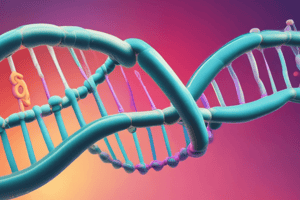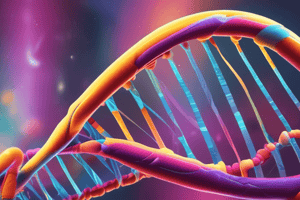Podcast
Questions and Answers
Which of the following enzymes is responsible for sealing gaps between newly synthesized DNA fragments during replication?
Which of the following enzymes is responsible for sealing gaps between newly synthesized DNA fragments during replication?
- DNA Polymerase III
- RNA Primer
- Ligase (correct)
- DNA Polymerase I
During translation, a ribosome reads three bases known as a ___.
During translation, a ribosome reads three bases known as a ___.
- codon (correct)
- terminator
- anticodon
- promoter
Which of the following amino acids is NOT an essential amino acid?
Which of the following amino acids is NOT an essential amino acid?
- Lysine
- Alanine (correct)
- Methionine
- Isoleucine
What type of mutation leads to the premature termination of protein synthesis?
What type of mutation leads to the premature termination of protein synthesis?
Which of the following statements accurately describes a silent mutation?
Which of the following statements accurately describes a silent mutation?
In which of the following processes does DNA polymerase III play a crucial role?
In which of the following processes does DNA polymerase III play a crucial role?
Where does transcription take place in eukaryotic cells?
Where does transcription take place in eukaryotic cells?
Which of the following mutations results in a change in the amino acid sequence of a protein?
Which of the following mutations results in a change in the amino acid sequence of a protein?
What does DNA stand for?
What does DNA stand for?
Which pairs of nitrogenous bases bond in DNA?
Which pairs of nitrogenous bases bond in DNA?
Where is the majority of DNA found within the cell?
Where is the majority of DNA found within the cell?
Which enzyme is responsible for unwinding the double-stranded DNA during replication?
Which enzyme is responsible for unwinding the double-stranded DNA during replication?
What characteristic does DNA replication exhibit?
What characteristic does DNA replication exhibit?
What role do specialized enzymes like DNA polymerases serve during replication?
What role do specialized enzymes like DNA polymerases serve during replication?
Which statement best describes a gene?
Which statement best describes a gene?
What percentage of human DNA is identical among individuals?
What percentage of human DNA is identical among individuals?
Flashcards
DNA
DNA
Deoxyribonucleic Acid; the molecule carrying genetic instructions for living organisms.
Double Helix Structure
Double Helix Structure
DNA’s twisted ladder shape formed by sugar-phosphate backbones and nitrogenous base pairs.
Nitrogenous Bases
Nitrogenous Bases
Four bases in DNA: Adenine (A), Thymine (T), Cytosine (C), Guanine (G), pairing A-T and C-G.
Replication
Replication
Signup and view all the flashcards
Semi-Conservative Replication
Semi-Conservative Replication
Signup and view all the flashcards
DNA Repair
DNA Repair
Signup and view all the flashcards
Helicase
Helicase
Signup and view all the flashcards
Primase
Primase
Signup and view all the flashcards
DNA Polymerase III
DNA Polymerase III
Signup and view all the flashcards
DNA Polymerase I
DNA Polymerase I
Signup and view all the flashcards
Ligase
Ligase
Signup and view all the flashcards
Transcription
Transcription
Signup and view all the flashcards
Translation
Translation
Signup and view all the flashcards
Non-essential Amino Acids
Non-essential Amino Acids
Signup and view all the flashcards
Essential Amino Acids
Essential Amino Acids
Signup and view all the flashcards
Point Mutation
Point Mutation
Signup and view all the flashcards
Study Notes
DNA Replication
- DNA carries genetic instructions for all living organisms' growth, development, functioning, and reproduction.
- DNA is shaped like a twisted ladder (double helix).
- Sugar-phosphate backbones form the sides of the ladder.
- Nitrogenous base pairs (A-T, C-G) form the rungs.
- Adenine (A) pairs with Thymine (T).
- Cytosine (C) pairs with Guanine (G).
- Hydrogen bonds hold the base pairs together.
- Nearly 99.9% of human DNA is identical across species, despite variations making individuals unique.
- DNA is found in the nucleus and mitochondria. Mitochondria DNA is inherited maternally.
- A single human cell contains about 2 meters of DNA
- DNA replication is semi-conservative, meaning each new DNA molecule consists of one original strand and one newly synthesized strand.
DNA Structure
- DNA is made of a sugar (deoxyribose), a phosphate group and a nitrogenous base.
- The sugar and phosphate form the backbone of the DNA double helix; the bases face inwards.
- Hydrogen bonds connect the base pairs of the DNA molecule.
- The four nitrogenous bases are: Adenine (A), Thymine (T), Guanine (G) and Cytosine (C).
Enzymes involved in DNA Replication
- Helicase unwinds and separates the double-stranded DNA.
- Topoisomerase relieves supercoiling tension in the DNA ahead of the replication fork.
- Single-Strand Binding Proteins (SSBs) prevent separated strands from reannealing.
- Primase synthesizes a short RNA primer to provide a starting point for DNA polymerase.
- DNA Polymerase III adds new nucleotides to the growing strand, extending from the RNA primer (5’ to 3’ direction).
- DNA Polymerase I removes RNA primers and replaces them with DNA nucleotides forming phosphodiester bonds.
- Ligase seals gaps between fragments, such as Okazaki fragments.
Central Dogma
- The central dogma describes the flow of genetic information from DNA to RNA to protein.
- Replication is the process for copying DNA.
- Transcription is the process of making RNA from DNA.
- Translation is the process of making protein from RNA.
Differences between DNA and RNA
- DNA is deoxyribonucleic acid; RNA is ribonucleic acid
- DNA is very stable (long life); RNA is less stable (short life)
- DNA is found in the nucleus, and mitochondria, plastids; RNA is found in nucleus and cytosols
- DNA has a double helix structure; RNA has a single strand structure
- DNA has deoxyribose sugar; RNA has ribose sugar
- DNA has A-T, C-G; RNA replaces T with U (A-U, C-G)
- DNA is usually very resistant to UV radiation; RNA is more sensitive to UV radiation
Protein Synthesis-Transcription
- Transcription takes place in the cytoplasm of prokaryotes and the nucleus of eukaryotes.
- DNA is used as a template to create an mRNA molecule.
- The mRNA molecule is complementary to a DNA strand.
Protein Synthesis-Translation
- The RNA sequence is translated into a sequence of amino acids to form a protein.
- The ribosome reads three bases (a codon) at a time from the RNA and translates them to an amino acid.
- There are twenty amino acids. Eleven are non-essential, synthesizable by the body; nine are essential, non-synthesizable by the body.
- Examples of non-essential amino acids include alanine, asparagine, etc. Examples of essential are tryptophan, methionine, etc.
Types of Gene Mutations
- Point Mutation (Substitution): A single nucleotide is replaced with another. Silent mutations do not change the amino acid sequence due to redundancy in the genetic code(example: AGA to AGG). Missense mutations cause a change in the amino acid sequence (example: GAG to GUG). Nonsense mutations result in a premature stop codon (example: UAC to UAG).
- Frameshift Mutation: Insertion or deletion of nucleotides shifts the reading frame of codons, altering the protein sequence. An example of an insertion mutation: AUG-AAA-GGC to AUG-GAA-AGG-C.
- Expanding Repeats Mutation: A repeated sequence of nucleotides expands, causing genetic disorders (e.g. Huntington's disease).
Studying That Suits You
Use AI to generate personalized quizzes and flashcards to suit your learning preferences.




